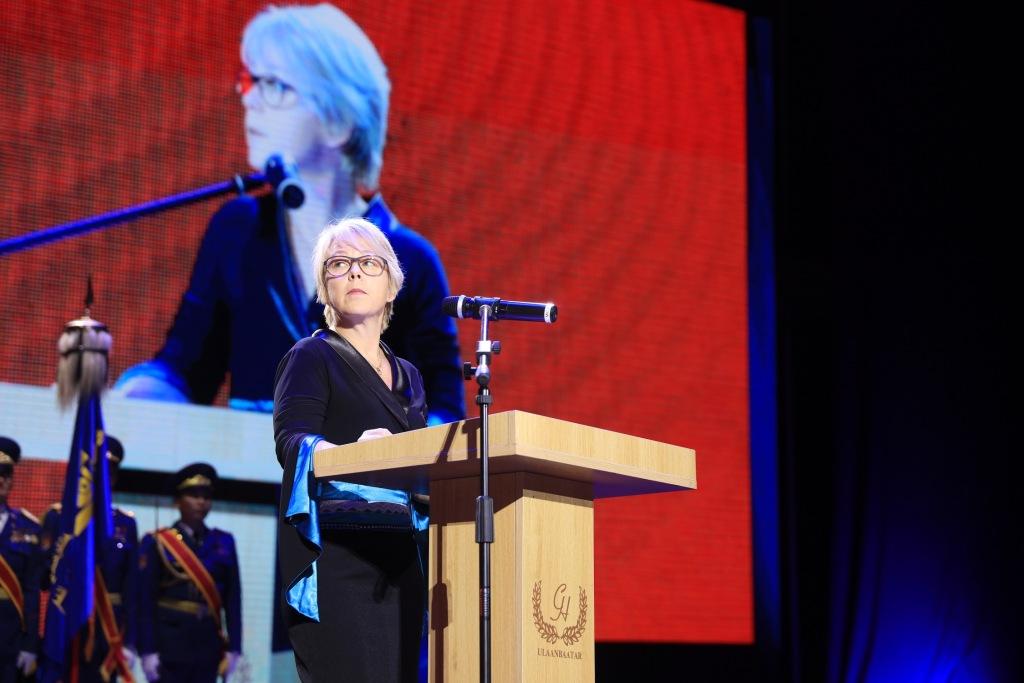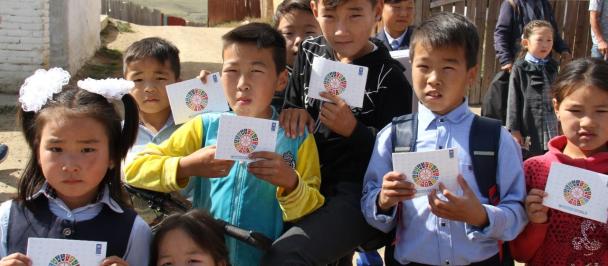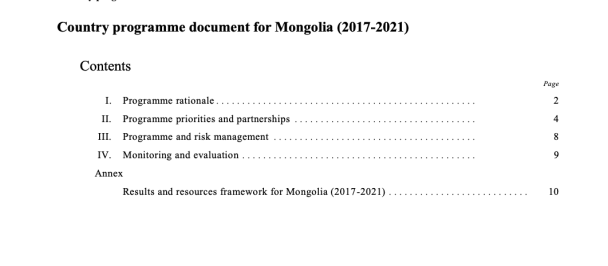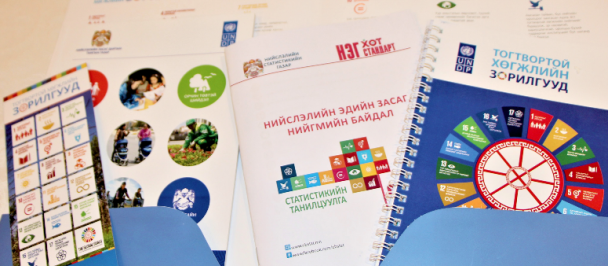Beate Trankmann, 2018. Photo by UNDP Mongolia
INTERNATIONAL CONFERENCE ONTHE SUSTAINABLE DEVELOPMENT GOALS: GENDER AND DEVELOPMENT
27-28 June 2018
Keynote Speech by Ms. Beate Trankmann, UN Resident Coordinator
“Achieving the SDGs Through Gender Equality”
Excellency Minister of Labor and Social Welfare Mr. Chinzorig
Honorable Mr. Enkh-Amgalan, Vice Speaker of the Parliament of Mongolia
Ms. Yolanda Fernandez-Lommen, ADB Country Director
Distinguished participants, ladies and gentlemen;
Thank you for inviting me to speak at this important event.
We are all born equal. Yet, across the world, men and women, are not always treated equally, nor do they always have the same opportunities to succeed. Too often, it seems, our gender affects how safe we are; how much we earn; and whether we lead. But equality is not an option; it is a right, enshrined in the 1948 Universal Declaration of Human Rights, and advanced by the UN Convention on the Elimination of Discrimination Against Women. In the era of the Sustainable Development Goals, gender equality takes on a new and amplified significance. Not only is it seen as an individual right, but as vital for our common future. Fighting inequality is a core principle of the SDGs, which include a specific goal – Goal Five- on gender equality and empowering all women and girls. But it’s also key to every SDG – to ending poverty, protecting the planet and promoting peace.
Why is this? We know from experience that without gender equality, countries cannot meet their full potential. Investments in women and girls reap rewards across society and generations – boosting incomes, life expectancy and education levels. Data we’ve reviewed shows women spend 90% of their income on their families, while men spend only 30%-40%. Working mothers and daughters put food on their tables, helping families avoid, for example, poverty, Goal 1, and hunger – Goal 2. This means more funds for household to afford clean energy, Goal 7, building more sustainable communities, Goal 11, and tackling climate change, Goal 13. We also find businesses led by women tend to focus more on sustainability.
As Hillary Clinton once said: gender equality “is not only the right thing to do, it’s the smart thing to do.” We cannot end poverty by excluding the economic potential of half the world’s population. Indeed, the World Bank warns the global economy is losing 160 trillion dollars in wealth, simply because of the gender pay gap. That’s about 23,600 dollars, lost by every person on earth.
The numbers are clear – our world would be richer if women played a greater part in it. Currently though, women remain more vulnerable to poverty and to crisis. Development gains, such as in health and welfare, can swiftly be reversed by economic recessions and natural disasters, for example. And during those hardships, it’s the women, especially in developing countries, who suffer most due to inequality of roles, resources and power, as well as cultural norms. In Mongolia’s recent downturn, poverty jumped by 37 percent with female-led households hit hardest. We also saw an alarming rise in maternal mortality, and many domestic violence shelters shut due to lack of funding, putting more women at risk.
For all these reasons, gender equality is essential for ensuring a prosperous, inclusive and sustainable future. In the words the UN Secretary General, Antonio Guterres, gender equality: ‘…is a powerful force for upholding the main promise of the 2030 Agenda: to leave no one behind.’
So, where does Mongolia stand? The Global Gender Gap Index (GGGI) ranks it 53rd out of 144 countries. That puts Mongolia behind Moldova (30th) – but ahead of many others, such as Hungary (103rd ) and Japan (114th).
This ranking reflects Mongolia’s progress on gender equality in education, the longer life expectancy of women and their role in the economy. I commend Mongolia’s policy efforts, such as Law on Promotion of Gender Equality (2011); along with the amended Law to Combat Domestic Violence taking effect in 2017 that criminalises domestic violence for the first time; and the National Program on Gender Equality (2017-2021). I’m also encouraged to see different sectors develop their own policies towards gender equality, including in finance, justice, education, agriculture, industry and social protection. 43% of all aimags also now have gender programs, tailored to local needs.
Today, Mongolia’s gender equality challenges resemble that of many developed countries. More work is, however, needed to resolve some critical remaining issues, including:
a) Boosting women’s political participation: Why – 94 years after gaining the right to vote and be elected – women account for only 17% of Mongolia’s parliamentarians, and no Aimag Governors? When women are in elected office, their needs are reflected in legislation. It was, for example, the Women’s group in Parliament that pushed for the Domestic Violence Law. Global evidence shows female MPs champion social and environmental issues more. As such, UNDP is proud to have trained over 2,000 Mongolian female elected representatives in local hurals between 2014 and 2016, to be change-makers in their communities.
b) Ensuring equality in work and pay: how do we encourage working women, and narrow the pay gap with their male counterparts, now at around 12.5%? The World Bank suggests enforcing non-discriminatory hiring, as well as responding to gender-specific needs, and expanding the quality and quantity of eldercare and childcare, so more women can work continuously. We also have to change attitudes among employers and society, to create a gender-sensitive, safe and inclusive work environment.
c) Ending gender-based violence: Two thirds of Mongolian women have experienced physical or psychological violence from their partners in their lifetime – a shockingly high figure. For the first time, thanks to the recent report by the NSO and UNFPA, we have wide evidence on the extent, depth and nuances of this complex social challenge in Mongolia. Violence in any form is unacceptable and must be stopped, through zero tolerance across society. Communities should be encouraged to report violence – which too often, remains hidden. We also need to change attitudes of boys, girls, men and women, through advocacy and early education.
d) Breaking with stereotypes: Gender inequality isn’t simply a women’s’ struggle. It’s about equal opportunities for women and men. In Mongolia, men are left behind, too. They live, on average, nine years less than women, compared to an average of four years less elsewhere. Unhealthy choices may be to blame – more than half of Mongolian men smoke, versus just over 7% of women. Beyond the statistics lies a deeper problem of gender ideals and stereotypes. This includes so-called ‘toxic masculinity’ – making it harder for men to ask for help, as this is seen as a weakness. Stereotypes also discourage men from playing a bigger role at home. In many families, women are now the main breadwinners. So, by taking on household jobs too, men can make valuable contributions to society – because it takes equal responsibilities at home, to ensure equal opportunities at work.
I am happy to say that on July 8th Mongolia will be joining the UN’s global HeForShe Campaign calling on all men and boys to step up and speak out for women and girls and for themselves - which is supported by celebrities such as Barack Obama, Justin Trudeau and Emma Watson.
Beyond campaigns, the complexity of gender challenges, and how they connect with every SDG, calls for system-wide, integrated responses. We must work across sectors – from public to private, health to education, the justice system, to workplaces and industries. Because gender equality cannot be achieved in isolation.
Firstly, we need clear, consistent, policies that are enforced, and well-defined targets that do not mask disparities. This means policies respond to barriers faced by men and women, respectively. To achieve this, gender-informed analytical tools should guide policy makers and policy formulation.
Secondly, we need to turn plans into budgets led by the SDGs – as stated in our joint UN-ADB report on SDGs Mainstreaming and Acceleration. Take the new Domestic Violence Law. With the law in effect, Mongolia must now ensure funding for its implementation, including for maintaining shelters, as well as training police and authorities in how best to protect and support victims. More broadly, it should prioritise investments encouraging gender equality, along with women’s economic and political participation, to benefit society at large.
Thirdly, we must monitor progress on gender equality at the Cabinet level, with clearly assigned responsibilities. Central and local officials should be held accountable for results, and given the up-to-date data they need to identify and address problems quickly.
The UN in Mongolia stands ready to support the government in each of these endeavors.
If history is anything to go by, I am certain Mongolia can do it. It was Mongolia, after all, that paved the way for gender equality more than 800 years ago, when Chinggis Khan banned the sale of women. His daughters went on to hold positions of political power, centuries before their counterparts in Europe, or Asia. In the 21st century, Mongolian men and women can achieve something, perhaps, even more ambitious in the SDGS, if they do so together.
Thank you!

 Locations
Locations




